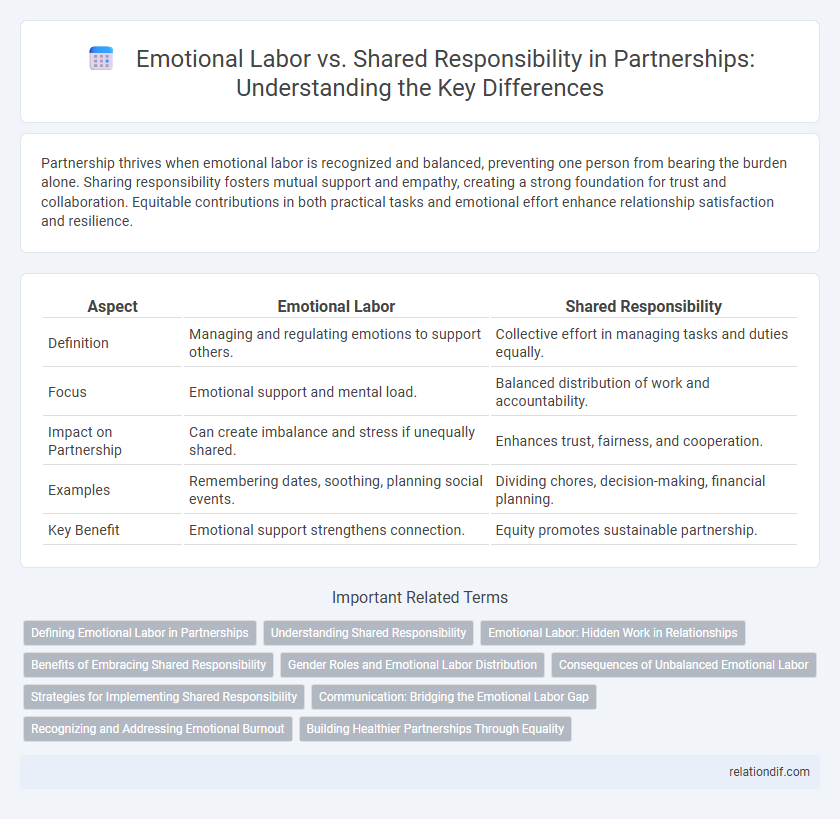Partnership thrives when emotional labor is recognized and balanced, preventing one person from bearing the burden alone. Sharing responsibility fosters mutual support and empathy, creating a strong foundation for trust and collaboration. Equitable contributions in both practical tasks and emotional effort enhance relationship satisfaction and resilience.
Table of Comparison
| Aspect | Emotional Labor | Shared Responsibility |
|---|---|---|
| Definition | Managing and regulating emotions to support others. | Collective effort in managing tasks and duties equally. |
| Focus | Emotional support and mental load. | Balanced distribution of work and accountability. |
| Impact on Partnership | Can create imbalance and stress if unequally shared. | Enhances trust, fairness, and cooperation. |
| Examples | Remembering dates, soothing, planning social events. | Dividing chores, decision-making, financial planning. |
| Key Benefit | Emotional support strengthens connection. | Equity promotes sustainable partnership. |
Defining Emotional Labor in Partnerships
Emotional labor in partnerships involves managing one's own emotions and the feelings of a partner to maintain harmony and support. It requires active empathy, communication, and often unseen efforts to address relationship dynamics and resolve conflicts. Recognizing emotional labor is essential for promoting shared responsibility, ensuring both partners contribute equally to the emotional wellbeing of the relationship.
Understanding Shared Responsibility
Understanding shared responsibility in partnerships emphasizes distributing emotional labor evenly between partners, fostering mutual support and reducing burnout. Recognizing each other's needs and actively participating in emotional tasks strengthens relationship resilience and promotes fairness. Shared responsibility encourages open communication and accountability, enhancing overall emotional well-being within the partnership.
Emotional Labor: Hidden Work in Relationships
Emotional labor in partnerships refers to the often invisible and unacknowledged effort involved in managing emotions, maintaining communication, and nurturing the relationship's emotional climate. This hidden work includes tasks such as remembering important dates, mediating conflicts, and providing emotional support, which disproportionately falls on one partner, leading to imbalance and potential resentment. Recognizing and sharing emotional labor fosters equitable partnerships and enhances relationship satisfaction and resilience.
Benefits of Embracing Shared Responsibility
Embracing shared responsibility in partnerships reduces emotional labor by distributing tasks and decision-making, fostering mutual respect and empathy. This balanced approach enhances communication, strengthens trust, and promotes long-term relationship satisfaction. Couples experience improved mental health outcomes and decreased stress when both partners actively contribute to household and emotional responsibilities.
Gender Roles and Emotional Labor Distribution
Emotional labor in partnerships often disproportionately falls on women due to traditional gender roles that assign caregiving and relational tasks to them. Shared responsibility in emotional labor promotes equitable distribution of tasks such as managing family dynamics, planning social events, and providing emotional support. Addressing gender biases in emotional labor can improve relationship satisfaction and overall partnership health.
Consequences of Unbalanced Emotional Labor
Unbalanced emotional labor in partnerships often leads to increased stress, resentment, and emotional exhaustion for the individual bearing the majority of the burden. This imbalance can cause communication breakdowns and decreased relationship satisfaction, potentially resulting in long-term dissatisfaction or separation. Prioritizing shared responsibility fosters mutual support, emotional equity, and a stronger, more resilient partnership.
Strategies for Implementing Shared Responsibility
Implementing shared responsibility in partnerships requires clear communication and defined role distribution to balance emotional labor effectively. Establishing regular check-ins fosters mutual support and accountability, ensuring that both partners actively contribute to emotional and practical tasks. Utilizing tools such as task-sharing apps or collaborative calendars can streamline responsibilities, reducing emotional strain and promoting equitable involvement.
Communication: Bridging the Emotional Labor Gap
Effective communication is crucial in bridging the emotional labor gap within partnerships by fostering transparency about each partner's mental and emotional contributions. Recognizing and openly discussing emotional labor tasks ensures shared responsibility and prevents unequal burdens from harming relationship dynamics. Prioritizing dialogue about feelings, expectations, and invisible labor strengthens trust and promotes equitable emotional investment.
Recognizing and Addressing Emotional Burnout
Emotional labor in partnerships often leads to burnout when one partner disproportionately manages feelings, conflicts, and relationship maintenance. Shared responsibility requires open communication and equitable distribution of emotional tasks to prevent exhaustion and promote mutual well-being. Recognizing emotional burnout early enables couples to implement strategies such as setting boundaries, seeking support, and rebalancing roles for a healthier dynamic.
Building Healthier Partnerships Through Equality
Emotional labor often falls unevenly in partnerships, leading to imbalance and resentment. Sharing responsibilities equitably fosters mutual respect and strengthens emotional connection, promoting healthier and more sustainable relationships. Prioritizing equality in emotional and practical tasks enhances communication and deepens trust between partners.
Emotional Labor vs Shared Responsibility Infographic

 relationdif.com
relationdif.com